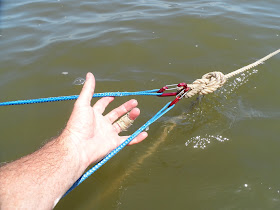If the rode is all-chain, yes, at least 30 feet of nylon is required to take the sting out of waves and wind gusts. Since multi-hulls use bridles to reducing yawing anyway, a nylon bridle is an elegant solution.
I usually attach the bridle with a prusik loop from a Dyneema climbing sling, but a knot is fast in light winds and I had misplaced the loop. A knot weakens the line and jams if the wind is over 20 knots (25 knots for a figure 8 knot), so I don't recommend it.
On the other hand, if the rode is nylon, it's easy to have too much stretch, to the point where fore-aft surging is actually increased, This leads to more impact and more yawing, since there is slack in the system. Logically, there is an optimum amount of spring in the system for a given yacht mass and sea state. A chain leader is another non-stretch element. By tuning the amount of chain, other non-stretch leader, and non-stretch bridle, motion can be minimized. 30-40 feet of nylon is good in relatively sheltered areas, and 80-120 feet is the most that is advisable. As much 300 feet is used with sea anchors in storms, but the wave conditions are unlike anything you would anchor in.
The other concern is stretch. A nylon bridle distorts when the load comes more to one side. The more it distorts, the more the boat yaws, and the farther it distorts. With a multi-hull bridle this may increase yawing 10-20 degrees. With a narrow monohull bridle, it may distort to where there is no bridle effect at all. For this reason, non-stretch bridles are better with drogues and sea anchors.
"How about polyester? It is low stretch also?" In fact, I used a polyester double braid bridle on my 34-foot PDQ when I had a nylon rode. It worked very well and was easy to handle. Dyneema works on the F-24 because it is left rigged all the time and Dyneema presents less drag through the waves and weight. It is also very UV resistant and has the best strength/dollar ratio available. It fits the small bow eyes and does not fatigue. Because the rode is recovered from the center hull using the main rode, I never handle it under load. But polyester was better on the PDQ and any application where it might be handled under load, whether by hand or winch.
Always something new.

No comments:
Post a Comment